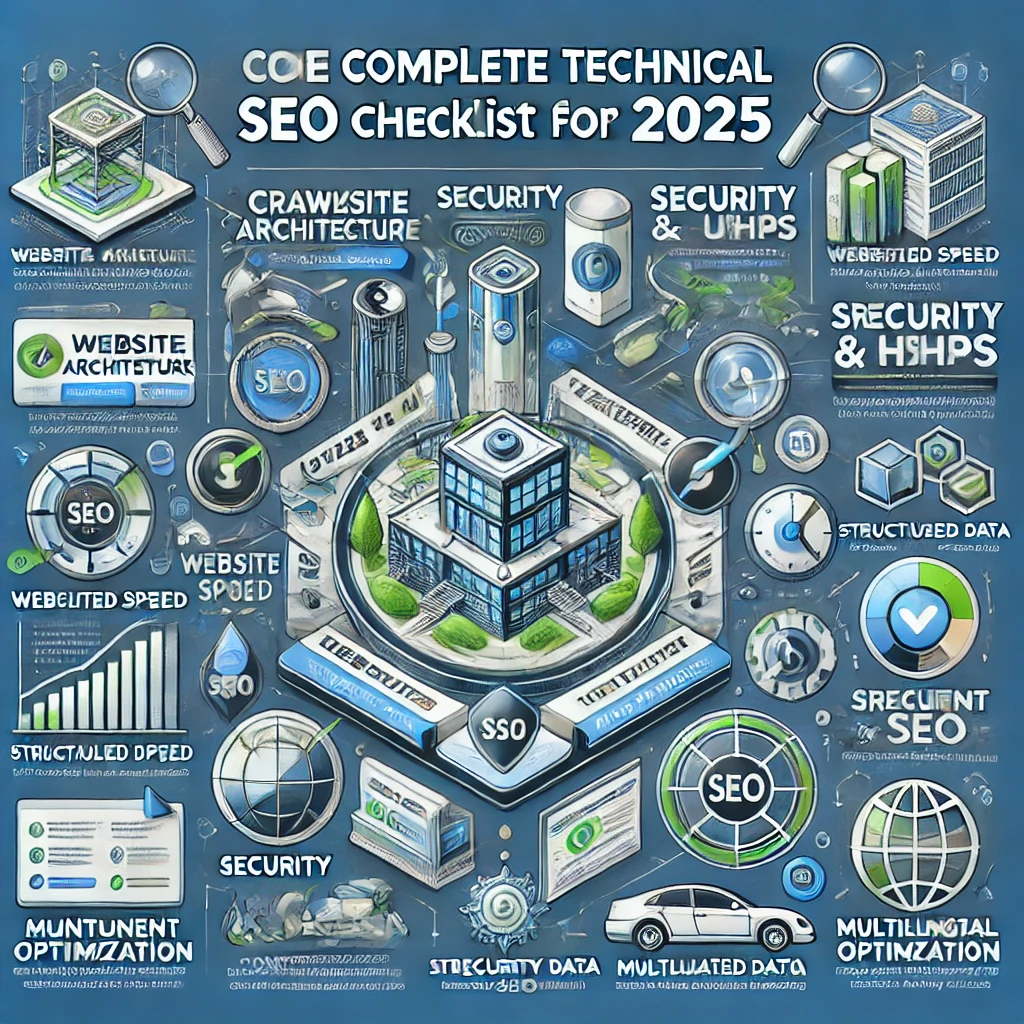Technical SEO is the foundation of a successful website. In 2025, the importance of optimizing your site’s technical aspects has only grown, as search engines prioritize user experience, speed, and security. Here is the most comprehensive and detailed technical SEO checklist to ensure your website is optimized for search engines and delivers a seamless user experience.

1. Website Architecture
a. Ensure Mobile-First Design
- Use a responsive design that adapts seamlessly to all screen sizes.
- Test mobile usability with Google’s Mobile-Friendly Test tool.
- Optimize font sizes, button placements, and navigation for mobile users.
b. Optimize URL Structure
- Keep URLs short, descriptive, and keyword-rich.
- Use hyphens to separate words (e.g., example.com/technical-seo-guide).
- Avoid special characters, numbers, and overly complex structures.
c. Implement a Logical Site Hierarchy
- Use a clear structure with main categories and subcategories.
- Limit the depth of clicks required to reach important pages (≤3 clicks).
- Ensure breadcrumbs are enabled for easier navigation.
d. Check for Orphan Pages
- Link all pages to the main structure to ensure they’re crawlable.
2. Crawlability and Indexing
a. Optimize Robots.txt File
- Allow access to essential pages and disallow private or duplicate content.
- Test your Robots.txt file with Google Search Console.
b. Submit an XML Sitemap
- Include all important pages in the sitemap.
- Ensure it’s updated dynamically and submitted via Google Search Console.
c. Fix Broken Links
- Use tools like Screaming Frog or Ahrefs to identify 404 errors.
- Redirect or fix broken links promptly.
d. Use Canonical Tags
- Specify the preferred version of a page to avoid duplicate content issues.
e. Implement Noindex Tags Where Necessary
- Add noindex meta tags to pages like admin panels, thank-you pages, or archives.
3. Website Speed and Performance
a. Optimize Core Web Vitals
- Largest Contentful Paint (LCP): Ensure key content loads within 2.5 seconds.
- First Input Delay (FID): Minimize delays to under 100ms.
- Cumulative Layout Shift (CLS): Maintain visual stability with CLS < 0.1.
b. Minimize HTTP Requests
- Combine CSS and JavaScript files where possible.
- Use asynchronous loading for scripts.
c. Enable Browser Caching
- Set cache expiration dates for static assets like images and stylesheets.
d. Optimize Images
- Use modern formats like WebP or AVIF.
- Implement lazy loading for below-the-fold images.
e. Use a Content Delivery Network (CDN)
- Distribute content across global servers to reduce load times.
f. Compress Resources
- Enable GZIP or Brotli compression for faster file delivery.
4. Security and HTTPS
a. Ensure HTTPS Is Enabled
- Obtain an SSL certificate and redirect HTTP to HTTPS.
- Use tools like Qualys SSL Labs to verify certificate integrity.
b. Implement HSTS (HTTP Strict Transport Security)
- Prevent protocol downgrade attacks by forcing HTTPS connections.
c. Secure Sensitive Directories
- Restrict access to sensitive directories like /wp-admin/ or /config/.
d. Protect Against Spam and Attacks
- Use security plugins like Wordfence or Sucuri for CMS platforms.
- Set up a Web Application Firewall (WAF).
5. Structured Data and Schema Markup
a. Implement Relevant Schema Markup
- Use schema for articles, FAQs, reviews, products, and local businesses.
- Use Google’s Rich Results Test to validate schema implementation.
b. Add Breadcrumb Markup
- Include schema for breadcrumbs to improve search visibility.
c. Use Open Graph and Twitter Cards
- Optimize social sharing with meta tags for Open Graph (Facebook) and Twitter Cards.
6. Content Optimization
a. Ensure Unique and Relevant Content
- Avoid duplicate content issues by auditing pages regularly.
b. Optimize Metadata
- Use descriptive and keyword-rich title tags (≤60 characters).
- Write compelling meta descriptions (≥155 characters) to improve click-through rates.
c. Use Heading Tags Correctly
- Structure content with H1, H2, H3 tags for clarity and hierarchy.
d. Add Internal Links
- Use relevant anchor text to link related pages.
e. Use ALT Tags for Images
- Describe images with ALT tags to improve accessibility and SEO.
7. International and Multilingual SEO
a. Use Hreflang Tags
- Specify language and regional targeting for multilingual sites.
b. Avoid Duplicate Content Across Regions
- Create unique content for each region’s audience.
c. Use Country-Specific Domains
- Use ccTLDs (e.g., .uk, .de) to target specific countries.
8. Analytics and Monitoring
a. Set Up Google Analytics 4
- Track key metrics like bounce rate, conversion rate, and page views.
b. Use Google Search Console
- Monitor crawl errors, index coverage, and keyword performance.
c. Regularly Audit Your Site
- Use tools like Screaming Frog or Sitebulb to identify technical issues.
d. Monitor Competitor Performance
- Use tools like Ahrefs or SEMrush to benchmark against competitors.
Conclusion
By following this exhaustive 2025 Technical SEO Checklist, you can ensure your website remains competitive in search rankings while providing an exceptional user experience. Regular audits, consistent updates, and adherence to SEO best practices will help you maintain long-term success in an ever-changing digital landscape.